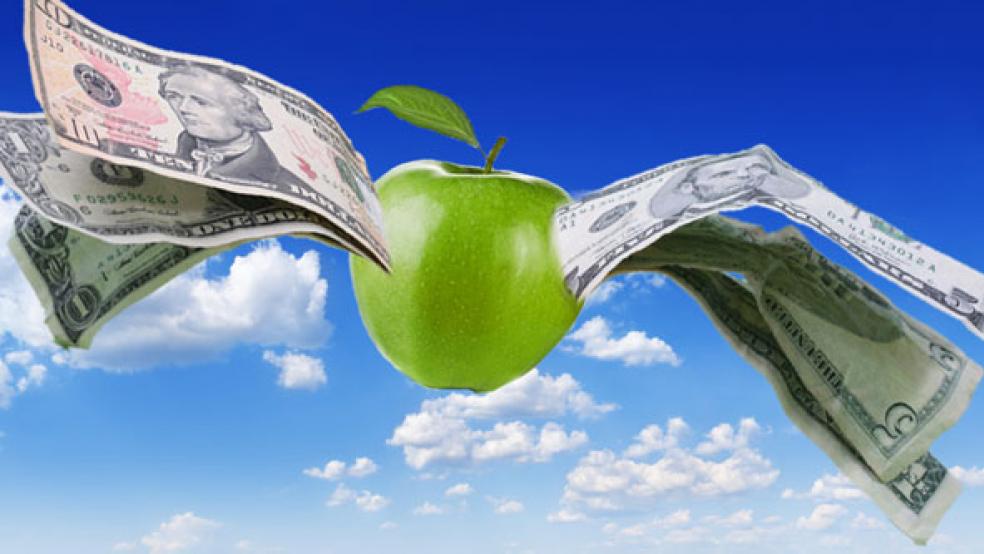Apparently, an apple sliced seven ways tastes all the juicier to some folks. At least it does when it’s a share of Apple (NASDAQ: AAPL), and the proposed one-for-seven stock split will bring the cost of a share down to a level that some investors will see as more accessible — in the mid-$70s, rather than bouncing around between $500 and $600.
The stock split was presented as part of the company’s fiscal second-quarter earnings announcement, which included a host of other measures carefully calculated to keep investors feeling warmer and fuzzier about Apple’s embattled stock than they have for the better part of two years. Big buyback? Check. Apple said it will boost its authorization to repurchase stock by $30 billion. Dividend increase? Yup. The dividend will rise 8 percent. Together, that will chip away at $100 billion of Apple’s cash mountain.
Shareholders also were happy with the fundamental results: stronger than expected earnings and gross margins.
Does all this really justify the 8 percent rally we witnessed in Apple’s stock Thursday? That’s another question altogether.
Apple has been so cheap for so long now (trading far, far below the average market multiple, and even after yesterday’s runup, still changing hands at only 13.5 times trailing earnings) that even those who aren’t determined bulls had kind of been yearning for something to happen to break the deadlock.
The problem is that Apple has become so damn big that it’s hard for anything to move the dial. So what if CEO Tim Cook brags about how acquisitive he has been, having snapped up two dozen businesses during his 18 months “on the prowl” for companies offering the right kind of technology? When your market capitalization brushes up against $500 billion, it’s fairly hard for even a series of acquisitions to generate a tremendous amount of buying enthusiasm among investors.
More than a one-quarter uptick in revenues, profits and gross margins, investors want to see signs that Cook has a stream of new products about to hit the market. A bland assertion that the company is working on “great stuff” doesn’t cut it any more than yet another iteration of the iPhone will be enough to satisfy critics for long.
That roster of critics includes analysts at GaveKal Capital, who published a rather pointed critique of Apple’s decision to spend its cash so lavishly on rewarding shareholders. The analysts calculate that Apple will devote $5 billion to $7 billion more to buybacks this year and next year than they are expected to generate in earnings. “We would prefer to see them accumulate more long-term (productive) assets,” GaveKal Capital argues. “Of the technology hardware companies, Apple has the smallest proportion of its assets represented by intellectual property and long-term assets.” (If you’re curious, top U.S. companies on that list include names like Seagate Technology and Western Digital.)
What was it that got other investors excited about Apple? History has shown that buybacks have an undistinguished track record when it comes to boosting a stock’s price, much less sustaining it. The dividend increase also shouldn’t have come as the sort of surprise that would propel shares so significantly. Apple has clearly signaled its intent to be an increasingly generous dividend payer. The earnings upside was welcome, but don’t rule out the stock split. It may yet turn out to be that — logic be damned — the seven parts are worth more than the whole had been.
That’s because now that Apple’s share price is no longer so stratospherically high relative to other securities, the odds of the company being added to the Dow Jones Industrial Average rise exponentially. It’s hard to suggest that it’s a less significant technology company than, say, IBM, which is less than half its size (as measured by market cap). And arguably, the index is a bit light on technology stocks since the departure of Hewlett-Packard from the mix, when it, Alcoa and Bank of America were replaced last year by Goldman Sachs, Nike and Visa.
The venerable Dow is a capitalization-weighted index, so adding a volatile stock with a price north of $500 to it when two-thirds of the other companies trade at less than $100 could be a recipe for trouble — especially when investors already have demonstrated they are worried about what’s happening to the market. Add Apple to the mix and a disappointing earnings number or an analyst downgrade might, on its own, be enough to send the Dow heading toward a 100-point loss, if the stock weren’t split.
A seven-for-one split, however, makes it a different matter altogether. Certainly, the company meets most other stated criteria for membership in the index.
In contrast to membership in the S&P 500, being added to the Dow Jones doesn’t automatically generate a big wave of buying from a vast number of index funds. The Dow is a smaller benchmark and, over the decades, has become less “investable.” Joining the Dow probably won’t matter much to Apple, except in prestige. It also isn’t going to matter all that much to the Dow, critics notwithstanding.
What does matter is that at $75 a share, Apple instantly becomes much more liquid — and much more digestible to a wider range of investors. Yes, it’s all an optical illusion, but sometimes, optics matter. The stock split also gives the company a chance to break free (in the eyes of non-professional traders, at least) of old price records and buzz phrases, like “the $700 club” (the group of analysts who, back in Apple’s glory days, were predicting its shares would top $700 apiece and race higher still).
Ultimately, however, what every Apple shareholder wants to see isn’t the choice between an entire apple and one sliced into seven pieces, but between the apple as it looks today, still slightly bruised and battered, and one that is twice the size, rosy and gleaming. Investors won’t care how many pieces it comes in.
Top Reads from The Fiscal Times:





